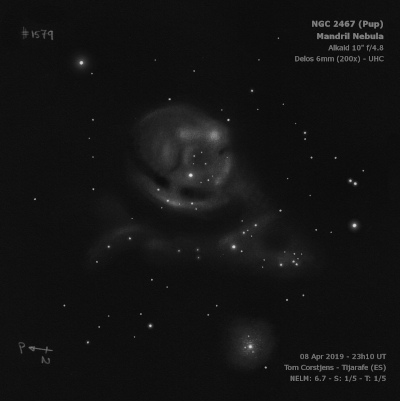
William Herschel discovered NGC 2467 = H IV-22 = h472 on 9 Dec 1784 (sweep 333) and recorded (two observations combined) "L, pB, almost R, easily resolvable, 6 to 10' diameter, a faint red colour visible. A star 8 mag not far from the center, but they evidently have no connection together. By second observation, 9 or 10' diameter." John Herschel observed it on 7 Jan 1831 (sweep 317) and wrote, "a * 9th mag with a W of stars and nebulosity, or ? is not a vF neb about the stars - no red colour seen."
Joseph Turner sketched NGC 2467 on 13 Jan 1877 with the Great Melbourne Telescope (p. 129 on his logbook, unpublished Plate V, figure 45) as an oval shaped nebula to the south of the bright star and brightest along the western side. See Harold Corwin's identification notes for more.
200/250mm - 8" (3/24/84): fairly bright, moderately large, roughly circular. A mag 8 star is north of center. This is a prominent nebulosity even with this aperture.
300/350mm - 13.1" (1/30/06 - Costa Rica): bright, large nebulosity at 75x using an OIII filter, ~4-5' diameter, surrounding a mag 8 star (O6-O7V star HD 64315, the ionization source). The main section is roughly mushroom shaped, extending generally south of the bright star. The southern border is locally brighter along a strip oriented NW to SE. There is a sharp light cut-off (apparently due to dust) passing to the north of the central star and oriented E-W. Faint haze extends ~15' to the east. To the north, fainter nebulosity extends 12' E-W, and brightens towards the east end at an elongated group of brighter stars (Haffner 18), oriented NW-SE. Removing the filter, NGC 2467 resides in a gorgeous low power Milky Way field with numerous faint stars peppering the region.
400/500mm - 17.5" (3/2/02): Using a 31 Nagler at 64x and an OIII filter, this is a prominent 7' nebulosity surrounding a mag 8 star. A dark lane appears to cut through the nebula from west to east starting NW of the central star. Fainter nebulosity extends beyond the dark lane but then fades out to the north. The south and southeast border of the main mass has a bright, distinct edge and the southern border has a small extension on the west edge which hooks towards the NW.
A finger of nebulosity extends north from the main body and involves a scattered group of brighter stars. This strip dims but nearly merges with a much larger, elongated mass of fairly faint nebulosity extending NW to SE at a roughly right angle. This section is ~15' in size with an irregular border that is bounded on the NE side by a string of brighter stars (Haffner 18). This is a fascinating HII complex to explore in a rich star field!
17.5" (1/23/88): at 82x with OIII filter appears as a large, bright, circular nebulosity about 10' diameter. A mag 7.8 star is involved north of center and several fainter stars are involved. The nebulosity is brightest along the south side in a strip oriented NW-SE. A group of brighter stars is NE (Haffner 18). A separate larger (~15') but fainter section is 10'-15' NE and appears elongated.
Notes by Steve Gottlieb